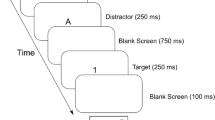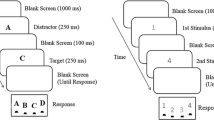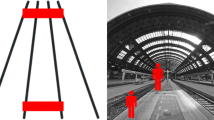Abstract.
Four experiments investigated the influence of a metacontrast-masked prime on temporal order judgments. The main results were (1) that a masked prime reduced the latency of the mask's conscious perception (perceptual latency priming), (2) that this effect was independent of whether the prime suffered strong or weak masking, (3) that it was unaffected by the degree of visual similarity between the prime and the mask, and that (4) there was no difference between congruent and incongruent primes. Finding (1) suggests that location cueing affects not only response times but also the latency of conscious perception. (2) The finding that priming was unaffected by the prime's detectability argues against a response bias interpretation of this effect. (3) Since visual similarity had no effect on the prime's efficiency, it is unlikely that sensory priming was involved. (4) The lack of a divergence between the effects of congruent and incongruent primes implies a functional difference between the judgments in the temporal order judgment task and speeded responses that have demonstrated differential effects of congruent and incongruent primes (e.g., Klotz & Neumann, 1999). These results can best be interpreted by assuming that the prime affects perceptual latency by initiating a shift of attention, as suggested by the Asynchronous Updating Model (AUM; Neumann 1978, 1982).






Similar content being viewed by others
Notes
One might argue that this control does not sufficiently exclude eye movements, and that therefore an eye movement or express saccade account of the data is feasible. In a yet unpublished experiment with EOG recordings, we found a PLP effect of 45 ms with a priming SOA of 48 ms. When we reduced data by eliminating those trials in which a vertical eye movement occurred (vEOG amplitude of more than 40 µV; targets were presented on the vertical midline in this study), the priming effect was 46 ms. There was no difference between the two sets of data (t[8] < 1). Though stimulus conditions in this experiment were not strictly comparable to the experiments reported in the presented study, these data do not favor an eye movement account.
The reason why the control condition was presented with as many repetitions as the four primed conditions taken together was that an equal number of primed and unprimed trials was required for the SD task, which was designed to match the TOJ task as closely as possible.
The basic assumptions of this model have formerly been referred to as Weather Station Model (see Neumann, 1982; Neumann & Müsseler, 1990).
References
Ansorge, U. (2000). Direkte Parameterspezifikation durch Positionsinformation: Sensumotorische Effekte maskierter peripherer Hinweisreize [Direct Parameter Specification by position information: Sensorimotor effects of masked peripheral cues]. Unpublished doctoral dissertation, University of Bielefeld, Bielefeld, Germany.
Ansorge, U., Heumann, M., & Scharlau, I. (2002). Influences of visibility, intentions, and probability in a peripheral cuing task. Consciousness & Cognition, 11, 528–545.
Ansorge, U., Klotz, W., & Neumann, O. (1998). Manual and verbal responses to completely masked (unreportable) stimuli: Exploring some conditions for the metacontrast dissociation. Perception, 27, 1177–1189.
Aschersleben, G. (1999a). Aufgabenabhängige Datierung von Ereignissen [Task-dependent timing of events]. Aachen: Shaker Verlag.
Aschersleben, G. (1999b). Task-dependent timing of perceptual events. In G. Aschersleben, T. Bachmann, & J. Müsseler (Eds.), Cognitive contributions to the perception of spatial and temporal events. Advances in psychology (pp. 293–318). Amsterdam, Netherlands: North-Holland/Elsevier Science Publishers.
Aschersleben, G., & Müsseler J. (1999). Dissociations in the timing of stationary and moving stimuli. Journal of Experimental Psychology: Human Perception and Performance, 25, 1–12.
Bachmann, T. (1984). The process of perceptual retouch: Nonspecific afferent activation dynamics in explaining visual masking. Perception & Psychophysics, 35, 69–84.
Bachmann, T. (1994). Psychophysiology of visual masking: The fine structure of conscious experience. Commack, N.Y.: Nova Science Publishers Inc.
Bachmann, T. (1999). Twelve spatiotemporal phenomena and one explanation. In G. Aschersleben, T. Bachmann, & J. Müsseler (Eds.). Cognitive contributions to the perception of spatial and temporal events. Advances in psychology (pp. 173–206). Amsterdam, Netherlands: North-Holland/Elsevier Science Publishers.
Bar, M., & Biederman, I. (1998). Subliminal visual priming. Psychological Science, 9, 464–469.
Breitmeyer, B. G. (1984). Visual masking: An integrative approach. Oxford, UK: Oxford University Press.
Breitmeyer, B. G., & Ganz, L. (1976). Implications of sustained and transient channels for theories of visual pattern masking, saccadic suppression, and information processing. Psychological Review, 83, 1–36.
Breitmeyer, B. G., & Ogmen, H. (2000). Recent models and findings in visual backward masking: A comparison, review, and update. Perception & Psychophysics, 62, 1572–1595.
Bridgeman, B. (1971). Metacontrast and lateral inhibition. Psychological Review, 78, 528–539.
Cave, K. R., & Bichot, N. P (1999). Visuospatial attention: Beyond a spotlight model. Psychonomic Bulletin & Review, 6, 204–223.
Cohen, J. (1977). Statistical power analysis for the behavioral sciences (2nd ed.). Hillsdale: New Jersey: Lawrence Erlbaum Associates.
Damian, M. F. (2001). Congruity effects evoked by subliminally presented primes: Automaticity rather than semantic priming. Journal of Experimental Psychology: Human Perception and Performance, 27, 154–165.
Dehaene, S., Naccache, L., Le Clec'H, G., Koechlin, E., Mueller, M., Dehaene-Lambertz, G., van de Moortele, P., & Le Bihan, D. (1998). Imaging unconscious semantic priming. Nature, 395, 597–600.
Eimer, M. (1999). Facilitatory and inhibitory effects of masked prime stimuli on motor activation and behavioural performance. Acta Psychologica, 101, 293–313.
Eimer, M., & Schlaghecken, F. (1998). Effects of masked stimuli on motor activation: Behavioral and electrophysiological evidence. Journal of Experimental Psychology: Human Perception and Performance, 24, 1737–1747.
Enns, J. T., & Di Lollo, V. (1997). Object substitution: A new form of masking in unattended visual locations. Psychological Science, 8, 135–139.
Enns, J. T., & Di Lollo, V. (2000). What's new in visual masking? Trends in Cognitive Sciences, 4, 345–352.
Fehrer, E., & Biederman, I. (1962). A comparison of reaction time and verbal report in the detection of masked stimuli. Journal of Experimental Psychology, 64, 126–130.
Fehrer, E., & Raab, E. (1962). Reaction time to stimuli masked by metacontrast. Journal of Experimental Psychology, 63, 143–147.
Finney, D. J. (1971). Probit analysis (3rd ed.). Cambridge: University Press.
Folk, C. L., Remington, R. W., & Johnston, J. C. (1992). Involuntary covert orienting is contingent on attentional control settings. Journal of Experimental Psychology: Human Perception and Performance, 18, 1030–1044.
Folk, C. L., Remington, R. W., & Wright, J. H. (1994). The structure of attentional control: Contingent attentional capture by apparent motion, abrupt onset, and color. Journal of Experimental Psychology: Human Perception and Performance, 20, 317–329.
Francis, G. (1997). Cortical dynamics of lateral inhibition: Metacontrast masking. Psychological Review, 104, 572–594.
Gibson, B. S., & Egeth, H. (1994). Inhibition and disinhibition of return: Evidence from temporal order judgments. Perception & Psychophysics, 56, 669–680.
Green, D. M., & Swets, J. A. (1966). Signal detection theory and psychophysics. N.Y.: John Wiley.
Haber, R. N., & Hershenson, M. (1965). Effects of repeated brief exposures on the growth of a percept. Journal of Experimental Psychology, 69, 40–46.
Hays, W. L. (1988). Statistics (4th ed.). Orlando, FL: Holt, Rinehart, and Winston.
Hershenson, M., & Haber, R. N. (1965). The role of meaning in the perception of briefly exposed words. Canadian Journal of Psychology, 19, 42–46.
Hopf, J.-M., Luck, S. J., Girelli, M., Hagner, T., Mangun, G. R., Scheich, H., & Heinze, H.-J. (2000). Neural sources of focused attention in visual search. Cerebral Cortex, 10, 1233–1241.
Jaskowski, P. (1993). Selective attention and temporal-order judgment. Perception, 22, 681–689.
Jaskowski, P., van der Lubbe, R. H. J., Schlotterbeck, E., & Verleger, R. (2002). Traces left on visual selective attention by stimuli that are not consciously identified. Psychological Science, 13, 48–54.
Jonides, J. (1981). Voluntary vs. automatic control over the mind's eye's movement. In J. B. Long, & A. D. Baddeley (Eds.), Attention and Performance, IX (pp. 187–203). Hillsdale, N.J., US: Erlbaum.
Jonides, J., & Yantis, S. (1988). Uniqueness of abrupt visual onset in capturing attention. Perception & Psychophysics, 43, 45–52.
Klotz, W. (1996). Handlungssteuerung ohne bewußte Wahrnehmung: Eine experimentelle Untersuchung zur motorischen Verarbeitung visuell maskierter Reize. [Action control without conscious perception: An experimental study of motor processing of visually masked stimuli]. Unpublished doctoral dissertation, University of Bielefeld, Bielefeld, Germany.
Klotz, W., Heumann, M., & Neumann, O. (2002). Electrophysiological activation by maked primes: Independence of prime-related and target-related activities. Manuscript submitted for publication.
Klotz, W., & Neumann, O. (1999). Motor activation without conscious discrimination in metacontrast masking. Journal of Experimental Psychology: Human Perception and Performance, 25, 976–992.
Klotz, W., & Wolff, P. (1995). The effect of a masked stimulus on the response to the masking stimulus. Psychological Research/Psychologische Forschung, 58, 92–101.
Leuthold, H., & Kopp, B. (1998). Mechanisms of priming by masked stimuli: Interferences from event-related brain potentials. Psychological Science, 9, 263–269.
Maylor, E. A. (1985). Facilitatory and inhibitory components of orienting in visual space. In M. I. Posner, & O. S. M. Marin (Eds.), Attention and Performance, XI (pp. 189–204). Hillsdale, NJ, US: Erlbaum.
Müsseler, J., & Aschersleben, G. (1998). Localizing the first position of a moving stimulus: The Froehlich effect and an attention-shifting explanation. Perception & Psychophysics, 60, 683–695.
Müsseler, J., & Neumann, O. (1992). Apparent distance reduction with moving stimuli (Tandem Effect): Evidence for an attention-shifting model. Psychological Research/Psychologische Forschung, 54, 246–266.
Neumann, O. (1978). Visuelle Aufmerksamkeit und der Mechanismus des Metakontrasts [Visual attention and the mechanism of metacontrast]. (Report No. 6/1978). Bochum, Germany: Cognitive Psychology Unit, Department of Psychology, Ruhr-University Bochum.
Neumann, O. (1979). Kann ein nicht bewußt repräsentierter Reiz eine Willkürbewegung auslösen? – Zur Interpretation des Fehrer-Raab-Effektes [Is a nonconscious stimulus able to initiate a voluntary action? – On the interpretation of the Fehrer-Raab effect]. In P. Wolff, & M. Tücke (Eds.), Report on the 3rd Psychology Meeting in Osnabrück, Germany, October 1979, Psychological reports from Department 3, Osnabrück University.
Neumann, O. (1982). Experimente zum Fehrer-Raab-Effekt und das "Wetterwart"- Modell der visuellen Maskierung [Experiments on the Fehrer-Raab effect and the "weather station" model of visual masking]. (Report No. 24/1982). Bochum, Germany: Cognitive Psychology Unit, Department of Psychology, Ruhr-University Bochum.
Neumann, O. (1989). Kognitive Vermittlung und direkte Parameterspezifikation. Zum Problem mentaler Repräsentation in der Wahrnehmung [Cognitive mediation and direct parameter specification. On the problem of mental representation in perception]. Sprache und Kognition, 8, 32–49.
Neumann, O. (1990a). Direct parameter specification and the concept of perception. Psychological Research, 52, 207–215.
Neumann, O. (1990b). Visual attention and action. In O. Neumann, & W. Prinz (Eds.), Relationships between perception and action: Current approaches (pp. 227–267). Berlin, Heidelberg, New York, Tokyo: Springer.
Neumann, O., Esselmann, U., & Klotz, W. (1993). Differential effects of visual-spatial attention on response latency and temporal order judgment. Psychological Research/Psychologische Forschung, 56, 26–34.
Neumann, O., & Klotz, W. (1994). Motor responses to nonreportable, masked stimuli: Where is the limit of direct parameter specification? In C. Umiltà, & M. Moscovitch (Eds.), Attention and Performance, XV: Conscious and nonconscious information processing (pp. 123–150). Cambridge, Mass.: MIT Press.
Neumann, O., & Müsseler, J. (1990). Visuelles Fokussieren: Das Wetterwart-Modell und einige seiner Anwendungen [Visual focusing: The weather station model and some applications]. In C. Meinecke, & L. Kehrer (Eds.), Bielefelder Beiträge zur Kognitionspsychologie [Bielefeld contributions to cognitive psychology](pp. 77–108). Göttingen: Hogrefe.
Pashler, H. (1998). The psychology of attention. Cambridge, MA: MIT Press.
Perry, R. J., & Zeki, S. (2000). The neurology of saccades and covert shifts in spatial attention: An event-related fMRI study. Brain, 123, 2273–2288.
Scharlau, I. (2002a). Leading, but not trailing, primes influence temporal order perception: Further evidence for an attentional account of perceptual latency priming. Perception & Psychophysics, 64, 1346–1360.
Scharlau, I. (2002b). Evidence against response bias in temporal order judgment tasks with attention manipulation by masked primes. Manuscript submitted for publication.
Scharlau, I. & Ansorge, U. (2002). Exogenous and intention-dependent control of attention shifts in dynamic displays. In: Würtz, R.P., &. Lappe, M. (Eds.), Dynamic Perception (pp. 89–95). St. Augustin: Infix.
Scharlau, I. & Neumann, O. (2003). Temporal parameters and time course of perceptual latency priming. Acta psychologica (in press).
Schiller, P. H., & Smith, M. C. (1966). Detection in metacontrast. Journal of Experimental Psychology, 71, 32–39.
Schwarzbach, J. (2000). Priming of eye movements by masked stimuli. Unpublished doctoral dissertation, University of Braunschweig, Braunschweig, Germany.
Shore, D. I., Spence, C., & Klein, R. M. (2001). Visual prior entry. Psychological Science, 12, 205–212.
Spence, C., & Driver, J. (1994). Covert spatial orienting in audition: Exogenous and endogenous mechanisms facilitate sound localization. Journal of Experimental Psychology: Human Perception and Performance, 20, 555–574.
Spence, C., Shore, D. I., & Klein, R. M. (2001). Multisensory prior entry. Journal of Experimental Psychology: General, 130, 799–832.
Steglich, C., & Neumann, O. (2000). Temporal, but not spatial, context modulates a masked prime's effect on temporal order judgment, but not on response latency. Psychological Research/Psychologische Forschung, 63, 36–47.
Stelmach, L. B., & Herdman, C. M. (1991). Directed attention and perception of temporal order. Journal of Experimental Psychology: Human Perception and Performance, 17, 539–550.
Stigler, R. (1910). Chronophotische Studien über den Umgebungskontrast. [Chronophotic studies on surround contrast]. Pflügers Archiv für die gesamte Physiologie, 135, 365–435.
Turvey, M. T. (1973). On peripheral and central processes in vision: Inferences from an information-processing analysis of masking with patterned stimuli. Psychological Review, 80, 1–52.
van der Heijden, A. H. C. (1992). Selective attention in vision. London, New York: Routledge.
Velden, M. (1982). Die Signalentdeckungstheorie in der Psychologie [Signal detection theory in psychology]. Stuttgart: Kohlhammer.
Vorberg, D., Mattler, U., Heinecke, A., Schmidt, T., & Schwarzbach, J. (in press). Invariant time-course of priming with and without awareness. In C. Kaernbach, E. Schröger, & H. J. Müller (Eds.), Psychophysics beyond sensation: Laws and invariants of human cognition. Hillsdale, NJ: Erlbaum.
Weisstein, N. (1966). Backward masking and models of perceptual processing. Journal of Experimental Psychology, 72, 232–240.
Werner, H. (1935). Studies on contour: I. Qualitative analyses. American Journal of Psychology, 47, 40–64.
Wiggs, C. L., & Martin, A. (1998). Properties and mechanisms of perceptual priming. Current Opinion in neurobiology, 8, 227–233.
Wolff, P. (1989, April). Einfluß des maskierten Testreizes auf die Wahlreaktion auf den Metakontrast [Effect of the masked test stimulus on choice reaction in metacontrast] Paper presented at the 31st Congress of Experimental Psychology, Bamberg, Germany.
Yantis, S., & Jonides, J, (1984). Abrupt visual onsets and selective attention: Evidence from visual search. Journal of Experimental Psychology: Human Perception and Performance, 10, 601–621.
Acknowledgements.
The research reported in this paper was supported by the Deutsche Forschungsgemeinschaft (DFG), Grant NE 366/5–1 to Odmar Neumann. We thank Elena Carbone, Ulrich Ansorge, Manfred Heumann, Hartmut Leuthold, Werner Klotz, and Michael Niepel for helpful comments on earlier versions of the manuscript, and Carsten Allefeld and Holger Kälberer for programming parts of the software.
A preliminary version of this manuscript containing parts of the experimental data was presented at the 4th Tübingen Conference on Perception, 2001, March 2nd – 4th, Tübingen, Germany, and at the Herbsttagung Experimentelle Kognitionspsychologie [Autumn Conference on Experimental Cognitive Psychology], 2000, December 1st – 3rd, Münster, Germany.
Author information
Authors and Affiliations
Corresponding author
Rights and permissions
About this article
Cite this article
Scharlau, I., Neumann, O. Perceptual latency priming by masked and unmasked stimuli: Evidence for an attentional interpretation. Psychological Research 67, 184–196 (2003). https://doi.org/10.1007/s00426-002-0116-3
Received:
Accepted:
Published:
Issue Date:
DOI: https://doi.org/10.1007/s00426-002-0116-3




